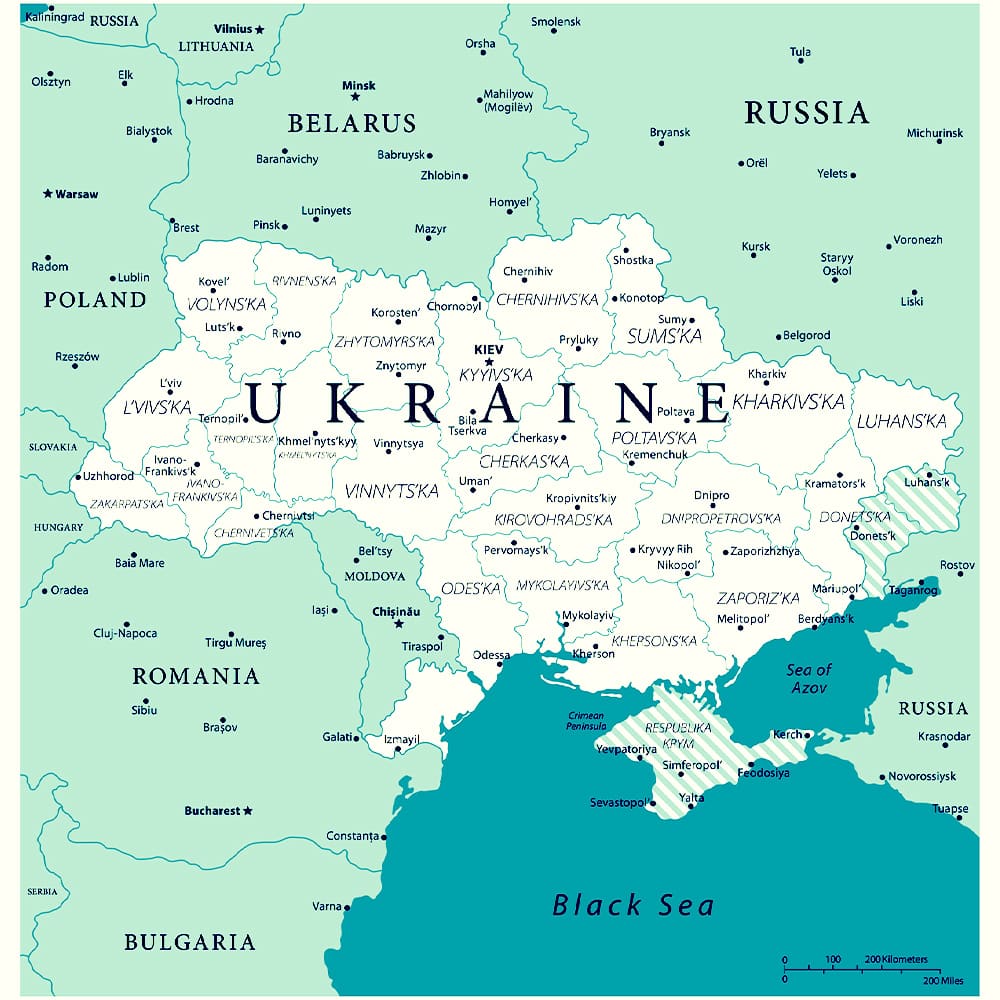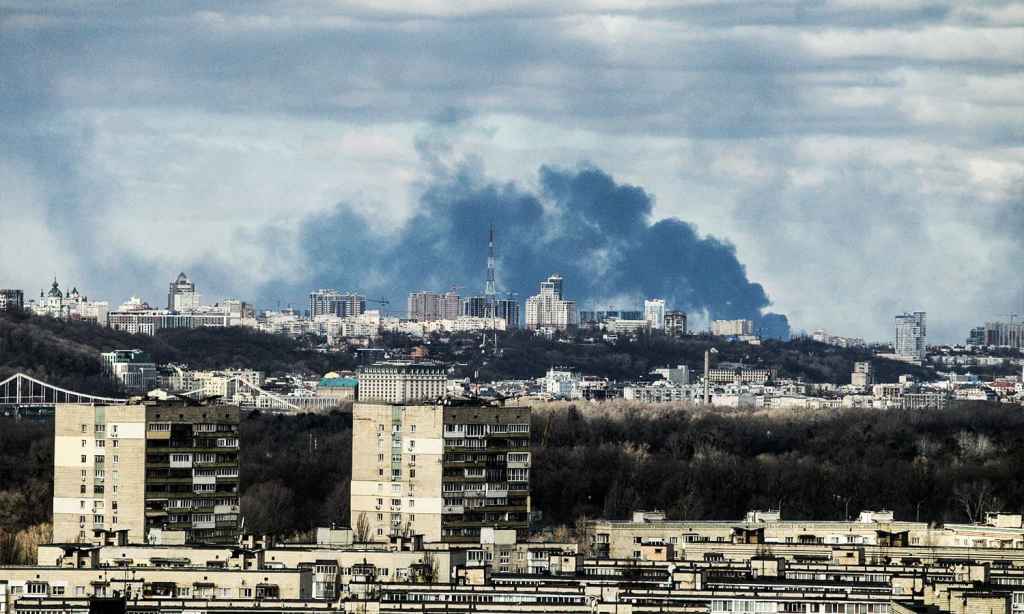When President Vladimir Putin took to Russian television screens in the early hours of Thursday morning to announce he was ordering a “special operation” across the border with Ukraine, he didn’t leave the world long to wonder what his ominous message might mean.
Within minutes, cruise missiles and rockets were raining down on targets throughout the neighbouring nation, laying waste to airports, military warehouses and a long list of other sites.
Behind the rockets came the troops, with tanks and columns of soldiers setting course for major cities. Since then, bloody firefights and heavy shelling have sent Ukrainians scrambling for shelter in basements and subway stations, and turned Moscow into an international pariah.
Now, with heavy sanctions causing a currency crisis and Western nations laying on shipments of arms to Kyiv, Putin has ordered the country’s nuclear deterrent to be put on high alert, blasting the “unfriendly” actions of foreign states.
Why Is Russia Doing This?
Last week, amid a worsening standoff with the West over NATO expansion, Putin signed a surprise order recognising the two breakaway territories in Ukraine’s Donbass region as independent states.
Donetsk and Lugansk have been held by Russian-backed separatists since the 2014 Euromaidan, when Ukraine’s pro-Moscow government was overthrown by mass protests. In a pre-recorded speech, the Russian president said that his country has a duty to protect Russian speakers, who make up a majority of the population in the war-torn east of the country where the rebels have been fighting Kyiv’s forces for eight years.
However, the separatists only had control of around a third of the territory they lay claim to — the Ukrainian army had taken back much of the land that made up the two regions when they split from Kyiv in 2014.
When Moscow recognised their independence, it did it within those frontiers and is now clearly committing itself to retaking the land for Donetsk and Lugansk by force. While that was, for most analysts, the worst case scenario after weeks of heightened tensions, Putin is clearly going far further than ever thought possible, and has launched an invasion of Ukraine as a whole, trying to destroy the country’s military capabilities.
Moscow’s self-declared objective is regime change. Describing the Ukrainian government as “drug addicts and gangsters,” Putin has resolved to “demilitarise and de-Nazify” the former Soviet Republic.
Citing “aggression” against the Donbass as his pretext, Russia’s long-time leader has also vowed to ensure Kyiv is never admitted to NATO, despite its leaders long-held aspirations to join the US-led alliance. According to him, its membership is a “red line” for Russia, claiming that American troops being stationed in the country would increase the risk of war between two nuclear powers.
After weeks of talks with Washington, in which Moscow’s diplomat’s aims to pressure the West into accepting their demands failed, the Kremlin has presented the invasion as an unavoidable self-defence measure.
In reality though, Ukraine was never likely to be admitted to the Western bloc, having been turned down for the last eight years. With the US and European nations now firmly offering Kyiv military assistance, this offensive itself has increased the chance of a conflict between the East and the West.
What Is Happening Now?
Russia’s armed forces have begun pushing into Ukraine from Crimea in the south, which Moscow annexed in 2014, and from the Russian and Belarusian borders in the north and the east. Troops had been stationed there for months prior to the start of the war, under the pretence of conducting military exercises. Rebels from Donetsk and Lugansk, supported by Moscow, have also made gains in the Donbass.

Russian soldiers have set up positions around much of Kyiv, cutting through the radiation exclusion zone around the Chernobyl nuclear power plant, with locals forced to take shelter from air raids and heavy shelling. Photos and videos coming out of the city appear to show residential buildings damaged and even a rocket strike against one apartment complex – which Moscow blames on the Ukrainians. There are fears that the city could fall, with few avenues of escape for civilians and political leaders.
However, the Ukrainian army has put up a valiant defence and, while reports are sketchy, it is clear that it has taken out a vast number of Russian tanks and aircraft. Defying predictions it would crumble at the first sign of trouble, the country has mobilised its entire population, handing out rifles to anyone able to hold one and fortifying cities with sandbags and anti-tank barriers. Moscow, meanwhile, has refused to admit it has lost any of its units and consistently denied its warplanes have been downed.
Another problem that has hindered Russia’s advance appears to be morale. A number of reports indicate that logistical planning has been poor and that troops were not told they were going to Ukraine until the very last moment — with many expecting to be sent on training missions instead. Clips showing tanks running out of fuel on the highways have prompted speculation that soldiers could be ditching their diesel in an effort to avoid getting to the front lines.
That said, Moscow has access to one of the world’s largest military arsenals and has only so far deployed a small fraction of its total manpower. It is clear that, for Ukrainians, the worst may be yet to come.
How Has the World Responded?
Much of the world has now imposed hard-hitting sanctions on Russia, with the UK and US among those targeting the country’s central bank, barring financial institutions from operating abroad. The EU has imposed penalties on top politicians and shut out Russian flights from its airspace, effectively sealing the country off. Australia has imposed sanctions against Putin and other top officials, while sending US$3 billion to Ukraine through a NATO investment fund. In a statement issued on Monday, Prime Minister Scott Morrison said that Moscow would be forced to pay “a high cost” for the attack on its neighbour.
Canberra has also joined a number of nations demanding that Russia be cut off from SWIFT, the financial payment mechanism that underpins almost all international transactions. The move — which was initially opposed by many countries that trade with Moscow — would effectively isolate it from foreign investment and make it hard for people to spend money abroad. A SWIFT shut off is now understood to be almost certain, after Germany and a number of other EU states backed the measure in response to the bloodshed.
The West is also sending large shipments of arms and even fighter jets to Ukraine, while Putin has pledged to hold other countries responsible if those weapons are used against Russia in the conflict. At the same time, Ukrainian President Volodymyr Zelenskyy has signed a formal application for the country to join the EU, with Brussels insisting that “they are one of us and we want them in.” However, while Kyiv’s accession would potentially open up the possibility of providing more support, and better enable refugees from Ukraine to resettle elsewhere, it could potentially increase the risk of hostilities between EU members and Russia.
What Do Russians Think?
One of the reasons many Western correspondents in Moscow were not convinced an invasion was on the cards, despite warnings from intelligence agencies like the CIA and MI6, was because of the lack of appetite among the public.
For weeks, officials said that the claims Russia was preparing an attack were “hysteria” and resolutely denied their country had any aggressive intentions, while state-run TV news mocked the growing fear across the border.
Few Russians seem to have been taken in by Putin’s talk of Nazis and NATO aggression, and one recent study from Moscow’s Levada Center pollster found that at least half of the 1,600 people surveyed were afraid of the consequences of such a war. However, despite the fact that most people seem to want peace, around 60% placed the blame for the conflict on the West or on Ukraine directly.
In major cities like Moscow and St. Petersburg, small but significant protests have broken out, with heavily-armoured riot police carting off demonstrators. Under Russia’s COVID-19 laws, restaurants, bars and clubs can operate without restrictions, but even a solo picket or holding up an anti-war sign is banned.
With sanctions beginning to bite, many Muscovites found their bank cards stopped working, with Apple Pay switched off on the metro. The cratering ruble has sparked a run on the banks, as people take out as much cash as they can and buy out supplies of US dollars. Those unable to get hold of foreign currencies have been investing their money in valuables, with electronics stores and jewellers reporting a scramble to buy up goods.
The prospect of job losses and economic chaos have come even before confirmation of Russian casualties, which are expected to be high. When the coffins begin flying back, it is likely to make an unpopular war even less popular.
What Could Happen Next?
On Monday, a delegation from Ukraine met with Russian diplomats in Belarus for talks that were hoped to put an end to the fighting. In a defiant move, Kyiv’s envoys demanded Moscow immediately order its troops to leave the country, as well as withdrawing from both Crimea and the Donbass. Meanwhile, the Kremlin is understood to want Zelenskyy to commit to adopting a formal status of neutrality, turning its back on NATO for good. Unsurprisingly, no deals have yet been done, but progress in some areas was apparently made.
That said, a peaceful settlement to the war is, at present, unlikely. While the Ukrainian armed forces have defied predictions and taken the war to Russia’s demoralised troops, the numbers are not in Kyiv’s favour. If the city falls, it is likely that the war will swing decisively in Moscow’s favour.
However, given how many Ukrainians are signing up to fight, making Molotov cocktails and organising defence units, even if Russia is able to occupy the country it would likely face a campaign of guerrilla warfare and civil unrest that would cost yet more lives.
Likewise, ousting Zelenskyy’s government and imposing a puppet ruler may be preferable to outright conquest, but is likely to face the same kind of resistance. Putin has few options, and none of them are good.
The invasion will redraw the map of Europe in more ways that one. While the West was initially disunited and arguing over potential sanctions, in the last few days it has found its feet and moved decisively to oppose Russia. More American forces are already deploying in nearby countries like Poland, Latvia and Lithuania, boosting NATO contingents, and talk of putting Moscow’s demands up for discussion has vanished overnight.
At home, Putin may face his toughest battle yet. Russian history is full of bloody revolutions and coups, and with skyrocketing prices and young men returning home from a war they never signed up for in body bags, there may soon be one more.
Gabriel Gavin is a Moscow-based freelance journalist covering the region for the likes of the BBC, The Independent, The Spectator and VICE News. You can follow him on Twitter.
If you want to help the people of Ukraine, you can find out how to do that here.
Read more stories from The Latch and subscribe to our email newsletter.







